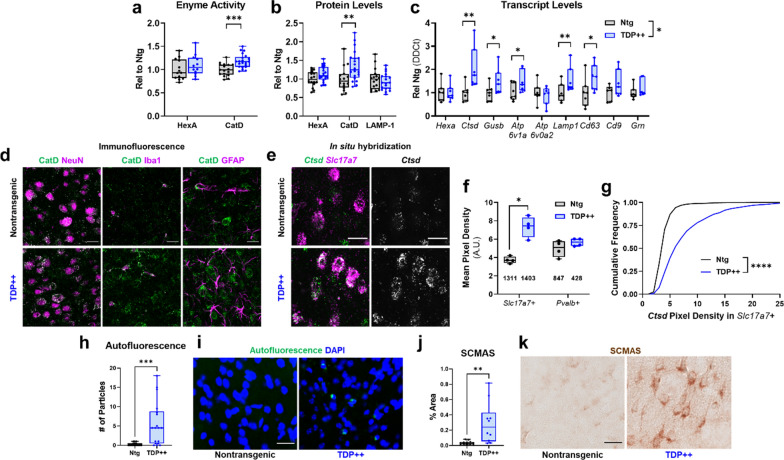Fig. 4.
A mouse model of TDP-opathy partially replicates the lysosomal abnormalities observed in patients with FTD-GRN or sporadic FTLD-TDP type A. a Homozygous TDP-43 transgenic mice (TDP++) had elevated CatD activity versus nontransgenic littermates (t test, p = 0.0004, n = 17–21 mice per genotype), though HexA activity did not differ between groups. b TDP++ mice had a corresponding increase in mature CatD levels (t test, p = 0.0075, n = 16–21 mice per genotype), but no significant changes in HexA (t test, p = 0.0704) or LAMP-1 (t test, p = 0.3807). c TDP++ mice also exhibited increases in several lysosomal genes that were elevated in patients with FTLD (MANOVA effect of genotype, p = 0.019, n = 7 mice per genotype). d CatD immunoreactivity in TDP++ mice was mostly neuronal, but also present in glia. e–g, in situ hybridization for Ctsd confirmed an increase in Ctsd expression in cortical vGlut1-positive (Slc17a7+) excitatory neurons (Mann–Whitney test, p = 0.0286), but not in parvalbumin-positive interneurons (Mann–Whitney test, p = 0.3429, n = 4 mice per genotype, number of cells analyzed is noted in f). The cumulative frequency of Ctsd labeling in Slc17a7 + excitatory neurons is shown in g (Kolmogorov–Smirnov test, p < 0.0001). TDP++ mice also accumulated storage material in frontal cortex, with an increase in autofluorescent particles (h, i Mann–Whitney test, p = 0.0002, n = 16–18 mice per genotype) and SCMAS (j, k Mann–Whitney, p = 0.0015, n = 10–11 mice per genotype). Scale bars represent 20 μm in (d, e, i, k). *p < 0.05, **p < 0.01, and ***p < 0.001 by t test in a and b, MANOVA between-subjects test in (c), ANOVA with Fisher’s LSD post-hoc test in (f), Kolmogorov–Smirnov test in (g), and Mann–Whitney test in (h, j)

